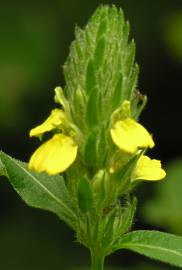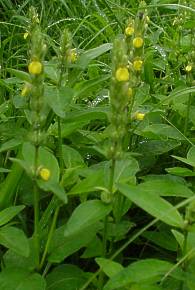Justicia flava
Justicia flava (Vahl) Vahl
Family: Acanthaceae
Common names: yellow justicea (Eng.); geelgarnaalbos (Afr.); impela (Zulu)
Introduction
Justicia flava is a ground cover which produces yellow flowers from September to May and is a good investment for a sunny spot in the garden.

Description
Description
Justicia flava is a perennial herb or shrublet, growing up to 450 mm high. The leaves are lanceolate or broadly ovate (egg-shaped), opposite, simple, entire, and the leaf stalk is about 1-25 mm long. The flowers are in a terminal inflorescence, and are subtended by large, leaf-like bracts. The petals of the 2-lipped, tubular flowers are pale to greenish with a bright yellow lower lip.

The fruit is a club-shaped capsule, which explodes to release the seeds. The seeds have water-absorbent hairs. Flowering is from September to May.
Conservation Status
Status
None.
Distribution and habitat
Distribution description
Justicia flava is a common species found in a number of different veld types especially in disturbed habitats, growing on a wide range of soil types, in full sun or semi-shady areas. It is widespread in tropical and southern Africa. It tolerates moderate frost. It is able to withstand dry conditions.
Derivation of name and historical aspects
History
The genus Justicia was named after James Justice (1698-1763), a Scottish horticulturist who worked on herbs and shrublets. The species name, flava, means yellow. It belongs to the family Acanthaceae, of about 246 genera which includes herbs, shrubs and climbers. Some other species in the genus are the yellow-flowered J. odora, and J. campylostemon with cream-coloured flowers. Common names include water-willow and shrimp plant, the latter name is derived from the inflorescence, which resembles a shrimp in some species.
Ecology
Ecology
Justicia flava is pollinated by insects and attracts various species of butterflies. The insects attracts insectivorous birds and therefore add more life in the garden.

Uses
Use
Justicia flava is used in traditional medicine to treat coughs.
It is a wonderful ground cover to use in sunny spots in the garden. Plant it with Plumbago auriculata to get a yellow and blue colour combination.

Growing Justicia flava
Grow
The seed capsules of Justicia flava burst open when ripe. To prevent the seeds from being lost, they should be collected as soon as the seed capsules turn brown. Sow the seeds in October. The seeds should be planted in a mixture of good soil, compost and river sand. Sow the seeds on the surface, pressing them down slightly. Place them in a shady spot and water them once a week with a fine sprinkler. Germination takes place after a week. Transplant seedlings when they reach a height of 200 mm.
Take cuttings during October and November, using stems of the previous season's growth. The cuttings should be 120 mm long and treated with a growing hormone such as Seridex no. 1. hormone powder. Place the cuttings in a mixture of good soil and river sand in equal parts. Ideal temperature for rooting is between 15-25ºC. Water twice a week. After rooting, transplant the cuttings in a good soil mixture and place them in 60% shade.
References
- Andrews, S. & McClintock, D. 1982. Notes on Restio subverticellatus. The Plantsman 37: 230-233.
- Baden, C., Balkwill, K., Getliffe Norris, F.M., Immelman, K.L., Manning, J.C. & Munday, J. 1995. Acanthaceae-Justiciinae. Flora of southern Africa 30, part 3, fascicle 1. National Botanical Institute, Pretoria.
- Brown, N., Jamieson, H. & Botha, P. 1998. Grow restios. Kirstenbosch Gardening Series. National Botanical Institute, Cape Town.
- Fabian, A. & Germishuizen, G. 1982. Transvaal w ild flowers. Macmillan, Johannesburg.
- Leistner, O.A. (ed.). 2000. Seeds plants of southern Africa : families and genera. Strelitzia 10. National Botanical Institute, Pretoria.
- Pooley, E. 1998. A field guide to wild flowers of KwaZulu-Natal and the Eastern Region. Natal Flora Publications Trust, Durban.
- Smith, C.A. 1966. Common names of South African plants. Memoirs of the Botanical Survey of South Africa No. 35.
- Van Wyk, B.-E. & Gericke, N. 2000. People's plants: a guide to useful plants of southern Africa. Briza Publications, Pretoria.
Credits
Willem Froneman
Lowveld National Botanical Garden
October 2008
Plant Attributes:
Plant Type: Ground Cover
SA Distribution: Eastern Cape, Gauteng, KwaZulu-Natal, Limpopo, Mpumalanga, North West
Soil type: Sandy, Clay, Loam
Flowering season: Early Summer, Late Summer
PH: Neutral
Flower colour: Yellow
Aspect: Full Sun
Gardening skill: Easy
Special Features:
Horticultural zones








Rate this article
Article well written and informative
Rate this plant
Is this an interesting plant?
Login to add your Comment
Back to topNot registered yet? Click here to register.